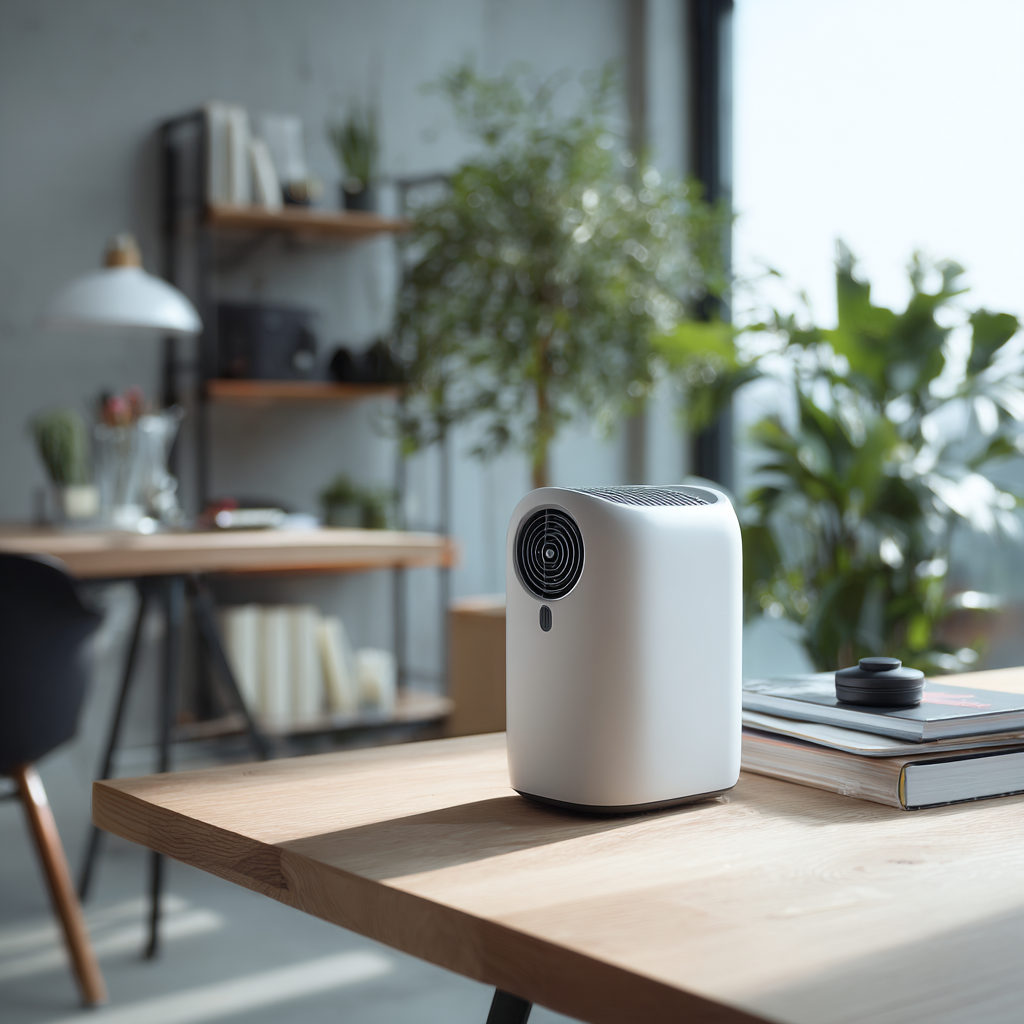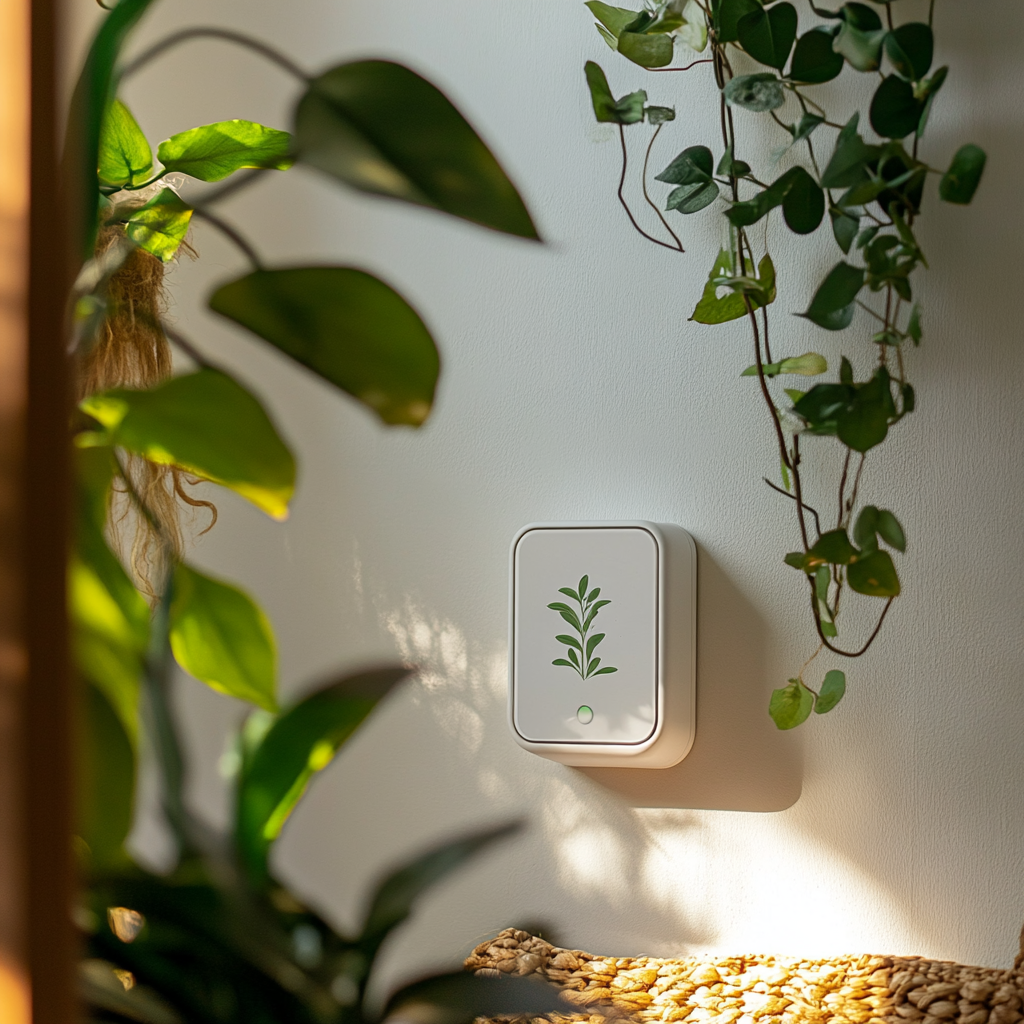If you’ve ever walked into your home and noticed a strange smell, or felt your allergies flare up for no reason, chances are the air quality wasn’t working in your favor. In small spaces, such as apartments or bedrooms, even minor pollutants can feel magnified. Dust, pet dander, particulate matter, cooking odors, and even smoke from a neighbor’s grill can easily linger in the air without proper circulation. Monitoring air quality is an often overlooked aspect of taking care of your home.
That’s where small air purifiers come in. These compact machines are designed to quietly clean the air without dominating your floor plan or draining your wallet. They are especially useful in a small bedroom or living rooms, where maintaining clean air is crucial. And the best part? They’re more powerful than you’d think, especially when they’re equipped with HEPA filters and carbon layers that trap tiny particles and neutralize odors.
Compact Air Purifiers
Compact air purifiers are a game-changer for anyone looking to improve indoor air quality in small spaces. Whether you’re outfitting a cozy bedroom, a busy home office, or a shared dorm room, these compact air purifiers are designed to deliver clean air without taking up valuable real estate in small rooms. Their sleek, space-saving designs make them easy to fit on a nightstand, desk, or shelf, so you can enjoy fresh air quality wherever you need it most.
One of the biggest advantages of a compact air purifier is its energy efficient operation. These devices are built to run quietly and efficiently, making them perfect for continuous use in small rooms. By filtering out dust, allergens, and odors, compact air purifiers help create a healthier environment, which can lead to better sleep, improved focus, and overall wellbeing. If you want to breathe easier and enjoy clean air in your dorm room, office, or any other small room, a compact air purifier is a smart, practical solution.
Benefits of Using an Air Purifier
Bringing an air purifier into your home or workspace can make a noticeable difference in your daily life. Air purifiers are designed to capture airborne particles like dust, pollen, and pet dander, which are common triggers for allergies and asthma. By removing these irritants, air purifiers help reduce sneezing, coughing, and congestion, making it easier to breathe comfortably indoors.
But the benefits don’t stop there. Many air purifiers also target volatile organic compounds (VOCs) and other harmful gases that can come from cleaning products, paints, or even new furniture. These substances can cause headaches, nausea, and other health issues if left unchecked. Air purifiers also help eliminate lingering odors and smoke, leaving your space smelling fresh and clean. By improving your indoor air quality, an air purifier creates a healthier, more inviting environment for you and your family.
Types of Air Purifiers
When it comes to choosing the right air purifier, it helps to know the different types available. HEPA filter air purifiers are among the most popular, thanks to their ability to trap 99.97% of particles as small as 0.3 microns. This makes them a top choice for allergy and asthma sufferers who want to remove dust, pollen, and pet dander from the air.
Activated carbon air purifiers are another great option, especially if you’re concerned about odors or smoke. These models use activated carbon to absorb gases and smells, making your space feel fresher. For those who love smart technology, smart air purifiers offer features like air quality sensors and Wi-Fi connectivity, so you can monitor and control your air quality from your phone or smart device. Each type of air purifier has its own strengths, so consider your specific needs when making a choice.
What to Look for in a Compact Air Purifier
Shopping for a small air purifier can get pretty overwhelming. There are dozens of models, each promising cleaner air and fresher rooms. But the real difference comes down to just a few features.
A true HEPA filter is a must if you’re trying to remove allergens like pollen, pet hair, or dust mites. It’s capable of trapping particles as small as 0.3 microns, which makes it an excellent choice for people with allergies or asthma. If you’re more concerned with how your place smells, like if you have pets, then an activated carbon filter can help absorb those lingering scents.
Noise level is also something to consider. In a bedroom or office, you want something that hums quietly in the background without interrupting sleep or calls. Models with “night mode” or low decibel ratings can help. Different fan settings can significantly affect noise output, and some models let you adjust these settings to balance comfort and operation.
Some compact air purifiers even come with smart features like air quality sensors and auto-adjusting fan speeds. These can be helpful if you’re not interested in fiddling with buttons all the time. A user-friendly control panel and safety features like a child lock can also be important for families.
And, of course, make sure the size fits where you plan to put it. Matching the air purifier’s capacity to your room size is crucial for effective air cleaning—a desktop air purifier for your nightstand is going to be totally different from the one in the corner of your studio apartment.
How Air Purifiers Work
Air purifiers operate by pulling in air from your room and passing it through a series of filters designed to capture unwanted particles and pollutants. As the air moves through the device, filters trap dust, pollen, pet dander, and even microscopic airborne particles, while some models also target gases like VOCs and smoke. The result is clean air that’s released back into your space, helping you breathe easier and enjoy a healthier environment.
Some air purifiers go a step further by including features like UV light or ionization, which can help neutralize bacteria and viruses. No matter the technology, the main goal is the same: to remove contaminants from the air and provide you with a cleaner, fresher living or working space.
Air Purifier Technologies
Modern air purifiers use a range of advanced technologies to tackle indoor air quality challenges. HEPA filtration is a gold standard, capturing 99.97% of tiny particles, including allergens and dust mites, making it ideal for those with sensitivities. Activated carbon filtration is another powerful tool, targeting gases, odors, and volatile organic compounds to keep your air smelling clean and free from harmful chemicals.
For those who want more control and insight, smart air quality sensor technology is a game-changer. These smart air sensors monitor your indoor air quality in real time and can automatically adjust the purifier’s settings for optimal performance. Some smart air purifiers even connect to your phone, allowing you to track air quality and manage your device remotely. By understanding these technologies, you can choose an air purifier that fits your lifestyle and ensures your indoor air stays as clean and healthy as possible.
The Best Small Air Purifiers of 2025
After reading through expert reviews and real user feedback, a few standout models have earned their place the top of the list.
Levoit Core 300 – Best Overall for Small Spaces
If you want a solid air purifier that does the job without the fuss, this is it. The Levoit Core 300 has earned its reputation as a go-to pick for small rooms. It features a true HEPA filter, runs quietly, and has a sleek design that blends into almost any room. It works best in spaces up to 219 square feet, with a clean air delivery rate (CADR) that matches its capacity and provides up to 5 air changes per hour in a typical small room. There’s also a sleep mode that dims the lights, which is a nice touch for nighttime use.
When running, its noise output is low, especially on the medium setting, making it suitable for bedrooms. On the highest setting, the noise increases but remains reasonable for quick air cleaning after exposure to poor air quality.
Blueair Blue Pure 411 Auto – Best for Style and Smart Features
This one is for people who want something that looks as good as it works. The Blueair Blue Pure 411 Auto has a modern, minimalist design and comes in different color options. Compared to all the purifiers in the Blueair lineup, the 411 Auto stands out for its compact size and smart features, making it ideal for small spaces.
It features a pre filter as the first stage of its filtration system, capturing larger particles and helping extend the life of the main filters. The built-in air quality indicator provides real-time feedback on airborne pollutants, so you always know your indoor air status. With auto mode, the purifier uses sensors to automatically regulate fan speed for optimal air cleaning without manual input. If you’re living in a small apartment or studio and want quiet performance with a little style, this purifier fits the bill.
AirDoctor 1000 – Best for Allergy and Asthma Relief
For people with respiratory issues, pets, or extreme sensitivity to pollutants, the AirDoctor 1000 is a standout. It uses UltraHEPA filtration, which captures particles even smaller than standard HEPA filters, including mold spores and other particulate matter. The main filter is designed for high efficiency, and the device’s app displays the filter life so you know exactly when a replacement is needed. Typically, the filter lasts up to six months before needing to be changed, making maintenance straightforward and cost-effective. While it’s more of an investment than some others, it’s a good option if your health or air quality needs are more serious. This purifier is compact enough for bedrooms or personal spaces but powerful enough to make a noticeable difference in your breathing.
Pure Enrichment PureZone Mini – Best for Desks, Travel and Dorms
This Pure Enrichment PureZone Mini is about the size of a water bottle and weighs under a pound. It’s designed for portability and personal use, whether that means at your desk, bedside table, or a small dorm room. The unit is highly efficient for its size, operating quietly and effectively even at lower fan speeds, and offers great value for its price.
It runs on a USB rechargeable battery and has multiple fan speeds. For ongoing maintenance, replacement filters are easy to find and simple to install, making filter replacements convenient and cost-effective. It won’t purify a whole apartment, but it’s perfect if you just want cleaner air in your immediate surroundings.
Coway Airmega AP-1512HH Mighty – Best for Small Apartments
If you’re looking for a little more coverage in a compact design, this model delivers. The Coway Airmega Mighty covers up to 361 square feet, which makes it great for studio apartments or open-concept living spaces. Compared to other models and other air purifiers in this category, it stands out with its four filtration stages, air quality sensor, and eco mode that shuts the fan off when the air is clean—features that some other models may lack. While it is more compact than larger units, it still functions as a powerful air purifier for its size and room coverage. Its overall performance in small apartments is excellent, offering efficient filtration, user-friendly features, and reliable operation.
Is a HEPA Filter Really Necessary?
If your goal is leaner air and better breathing, yes, a HEPA filter matters. True HEPA filters are a type of particle filter used in most air purifiers. They meet a very specific standard, removing at least 99.97% of particles that are 0.3 microns in size. That includes allergens, smoke particles, and even some bacteria.
There are plenty of products that use terms like “HEPA-like” or “HEPA-type,” but these aren’t held to the same standard. They might filter some of the air, but if you’re dealing with asthma, allergies, or poor ventilation, those knock-off versions aren’t going to cut it.
That said, if your main concern is odor control, an air purifier with a good carbon filter might be enough to do the job, even without HEPA.
Matching the Air Purifier to the Space
Different rooms need different kinds of coverage. In a bedroom, quiet performance and dim lighting options are important, since most people run their air purifiers overnight. That’s where the Levoit Core 300 shines! With coverage up to 219 sq ft, it’s quiet on lower speeds and has a sleep mode that dims the display lights. Running it on a medium setting or lower speeds keeps noise at a level similar to normal conversation, making it ideal for bedrooms.
For workspaces or home offices, smaller purifiers designed to sit on a desk are great for keeping dust and allergens from building up near your computer or paperwork. The PureZone Mini covers up to 54 sq ft, is easy to move around, and blends in without drawing attention. Adjusting the speed setting allows you to balance noise and performance, so you can work without distraction.
Dorm rooms benefit from small, portable purifiers that won’t get in the way of a crowded layout. If you’re sharing space with a roommate, an air purifier can make a big difference in odor and air quality. Rechargeable models are especially useful in spaces with limited outlets, and many cover up to 100 sq ft—suitable for most dorms. Using a medium setting helps maintain clean air without excess noise.
In small apartments where rooms aren’t clearly divided, you’ll want a purifier with a bit more power. Something like the Conway Mighty can handle up to 361 sq ft, making it suitable for the mixed air of a living room and kitchen combo without taking up much floor space. Adjusting the speed setting lets you keep noise at a comfortable level, similar to normal conversation, even in larger spaces.
Keeping Your Air Purifier in Good Shape
Maintenance isn’t complicated, but it does matter. Timely filter replacements are essential for optimal performance. You’ll want to replace the main filter as recommended, usually every 6 to 12 months for HEPA filters and a bit more often for carbon ones. Most models include a filter change indicator, but you can also use an air quality monitor or review test data to determine when the main filter needs to be replaced, ensuring your purifier continues to operate efficiently.
It also helps to wipe down the exterior occasionally and vacuum the vents. Dust can build up over time and block airflow, making your purifier less efficient. And if the machine starts to sound louder than usual, that’s often a sign it’s time for a new filter.
If you live in a high-pollen area or have pets, don’t be surprised if you need to replace filters more often than the manual suggests. Keeping a few replacements on hand can help you stay ahead of allergy season or unexpected air quality dips.
Final Thoughts
The best air purifier for your needs isn’t just the one with the highest specs or the most advanced features—it’s the one that fits your space, your routine, and your personal requirements. Some of the best air purifier models are whisper quiet, making them ideal for bedrooms or nurseries, while others offer a child lock feature for added safety in homes with young children. If you live in an area affected by wildfire smoke, look for models specifically tested for their effectiveness against such contaminants. Keep in mind, however, that air purifiers do not remove carbon dioxide, so proper ventilation is still important, and they do not clean other surfaces like furniture or floors.
Air quality often goes unnoticed until it starts to affect your comfort. Investing in a compact air purifier is a simple way to take control of the environment you spend most of your time in. Whether it’s allergies, odors, or just the peace of mind that comes with cleaner air, the right purifier can make a real difference—even in the smallest of spaces.
At Homeowner.org, we’re here to guide you along the way in your journey regarding all things related to buying, owning, and loving your home. Check out our site for more today.


